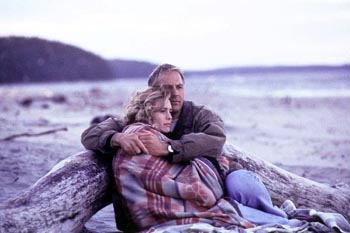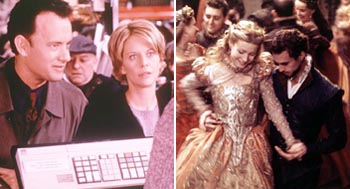![[Metroactive Movies]](/movies/gifs/movies468.gif)
[ Movies Index | Metro | Metroactive Central | Archives ]
Clichés in a Bottle
 Out of the Bottle: Robin Penn Wright beaches Kevin Costner after finding his plaintive cry. Today's therapeutic date movies rarely display the kind of complexity and nuance that nurtures real romance STOP ME if you've heard this one before. Theresa Osborne (Robin Penn Wright) is a Chicago Tribune writer too busy to have a boyfriend. Her office follows the standard Mary Tyler Moore layout, complete with fat, gruff, kindhearted editor (Robbie Coltrane) and Rhodaesque (Rhodesian?) wise-gal best friend (Illeana Douglas, the thinking-man's Calista Flockhart). While on vacation at the seashore, Theresa discovers a bottle with an anonymous romantic message inside--an open letter of regret and longing from a widower addressed to his late wife containing the words he could never say to her when she was alive. Theresa prints the message in her paper, and though the sentiments seem to have been transcribed from a Harlequin paperback, they open the hearts of readers everywhere. Smitten, our heroine heads for the Carolina coast to find the messenger. He turns out to be Garret Blake (Kevin Costner), a sensitive boat builder still devastated by the memory of his dead wife. Some critics will call Message in a Bottle (which opens Feb. 12, just in time for Valentine's Day) the most romantic movie of the year. Indeed, it is the perfect 1999 romance: a love story about a man and his grief therapist. A celluloid crying towel like Message in a Bottle isn't the worst example of the moribund romantic movie to be released recently. Unlike You've Got Mail, it doesn't counsel hopeless amorous surrender to the forces of merger capitalism, and photographer Caleb Deschanel's seascapes provide some of the emotions that Costner keeps locked up in his seaman's trunk. But watching Costner play yet another wounded bird makes one wonder again--what has happened to the romantic film? Is there such a thing today? Writing about the romantic film in 1999 is like writing about the Swiss Navy. The makers of would-be romantic movies face the same problems as anyone else on a first date. Worried about the response of the audience they're courting, filmmakers ponder how far they can go, how soon and how fast. Which may be why the classic-era movies, with their strong rules about what sort of sex is permitted--i.e., none--had the confidence to be more romantic than today's tentative efforts do. Film critic Anthony Lane of The New Yorker has a convincing suggestion about why the romantic movie is in decline. Today's couples, he argues, succumb right away to sex instead of holding it off conveniently for that final kiss as the music comes up. Boy meets girl, boy and girl go straight to bed, and there's still an hour left of movie. Lane's argument is a sad one. So our own promiscuity has condemned the romantic movie--it's dying for our sins! No wonder filmmakers are relying on the gimmick of the epistolary long-distance romance (Message in a Bottle, You've Got Mail, Sleepless in Seattle) to keep lovers apart up until the last few minutes. (Next Stop Wonderland, one of the better date movies of last year, held its lovers in their separate corners with plenty of subplots. The couple weren't even really introduced to one another until the last moment of film.) The argument that modern sex has killed off romantic movies implies that the old romantic-movie structure is the only one worth following. Many of the favorite romantic plots have aged beyond good use except in historical pictures. Onscreen, a woman's hard choice between a rich boy and a poor boy always looks like the old-fashioned plot device it is. No sympathetic film heroine would seriously consider marrying for money instead of love today--not in an American movie, anyway. Titanic functioned as it did because it was a period piece. The hit romance informed the young girls who wept over it that once upon a time girls like them were groomed for loveless marriages, even to "inconceivable bastards" like the one Billy Zane plays. (There was a backlash against Titanic from women who felt that Kate Winslet's character had it made--why would she risk losing all of Zane's money by sleeping with the pauper played by Leonardo DiCaprio? I said it was backlash. I didn't say it was intelligent backlash.) The far superior Shakespeare in Love is another reminder of the hard financial facts that informed marriages right up until our lifetimes. By telling a tale of doomed romance between the classes, Shakespeare in Love explains that escape from the hard economic facts of marriage was to be found only in art.
LOOKED AT COLDLY, the rotting away of the old conventions of romantic movies is a sign of social freedom. Today, women--or so American audiences would like to believe--don't have to suffer marriages to insane husbands. They don't have to give up their illegitimate children to married friends to save their reputations. In current movies, the one thing a woman is compelled to do is die. That's why cancer is an ever-popular narrative hook in romance movies. It's the only way a noble heroine can still submit to fate without losing her feminist credentials. The modern romantic movie is made to climax in one of two ways: death or perfect happiness. This rigid option may blind us to the long tradition of ambiguous endings for romantic films. Ernst Lubitsch, the great director of romantic films, held few illusions about married life, knowing that it was as fragile as any other sort of life. Nothing in You've Got Mail is as bleak and profound as one scene in its source, The Shop Around the Corner (1940)--the moment when Frank Morgan, realizing that his wife is unfaithful, sighs, "I guess she didn't want to grow old with me." Preston Sturges' The Palm Beach Story (1942), a pretty much perfect romance, ends with the title "And they lived happily ever after--or did they?" Rene Clair's It Happened Tomorrow (1944), recently released on video, begins at the 50th wedding anniversary party of Linda Darnell and Dick Powell. The story then heads into the past to tell how the couple met; he was a reporter, she was a stage psychic in a magic show. At the end of the movie, Darnell imagines their anniversary wedding party 50 years in the future. The film apparently ends where it begins. But even if we've visited their 50th anniversary party, is it real? Is Darnell's prediction of marital happiness any more true to life than the phony predictions she's made in her nightclub act? The unusual ending of It Happened Tomorrow anticipates the end of Raising Arizona, in which Nicolas Cage's character, Hi, tells of his dream of a future for his unhappy marriage. In his dream, the children he and his wife have as yet been unable to conceive gather around him at Thanksgiving. Hi's dream is shown to us in slow-motion, touched with cartoonish unreality. It's a fantasy--and likely a hopeless fantasy. I'd argue that open endings are always the most romantic. Consider the possibility of Scarlett and Rhett's reunion, despite the break between them, or the finale of Casablanca, in which the winning of the war is more important than a love affair. In the wisest romantic films, a happy ending is no more guaranteed for a movie's characters than it is for the rest of us. WHEN LOOKING FOR romance, I usually end up going back to older films. Director Howard Hawks, for instance, although noted for his actioners and Westerns, made some of the best date movies ever. The Big Sleep (1946) shows a balance between the men and women that seems extinct in current movies. The friendly tryst between Philip Marlowe (Humphrey Bogart) and a clerk at a bookstore (Dorothy Malone), improvised on the spot according to Hawks, is a model of how to handle an equally matched man and woman. His Girl Friday (1941) is a great date movie, not because it puddles a viewer through death scenes and separations, but because it flatters the viewer's intelligence. Leading man Cary Grant exudes so much self-confidence that it seems to rub off on you as you watch him. A couple in a theater can't help but feel more attractive for sharing Cary Grant's company. Hawks directed movies for an audience presumed to be smarter than the average person; his films are much more romantic than movies that suggest we're all just sloppy fools in love--as in the erstwhile romance There's Something About Mary. The most romantic moment of last year was the love scene in Steven Soderberg's Out of Sight. Jennifer Lopez is framed by the window of a cocktail lounge on the top floor of a business hotel. It's a quick picture of modern loneliness. Everything except Lopez looks cold to the touch. Hundreds of feet below her, under starless black skies, is an immense plain covered with snow: the city of Detroit. Lopez, alone, holds a drink. Several jackass salesmen try to pick her up. Like good salesmen, they're not taking no for an answer. Finally, George Clooney--her love, her quarry--walks in and asks for a seat. Seeing Clooney is like seeing Grant. Both give the sense of a casual elite that must walk somewhere else besides the screen. How to describe them? As people who have their souls in their own keeping? Their love scene is playful, awkward; we can see that between them is a will that must find a way. Call it romance. Maybe some element of rescue is involved in the best romantic films--rescue from the dull, from the fools. It's a slightly different approach from the message-in-a-bottle plot, because in the smartest romances, the characters are capable of rescuing themselves. A message in a bottle usually reads "Help." The idea "You are the only possible one in the world" is a long, long step down from "I know there are many other people in the world, but I choose you." [ San Jose | Metroactive Central | Archives ]
|
From the February 11-17, 1999 issue of Metro.
Copyright © Metro Publishing Inc. Maintained by Boulevards New Media.
